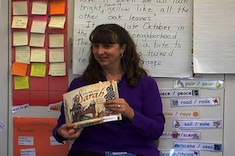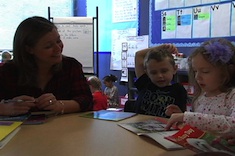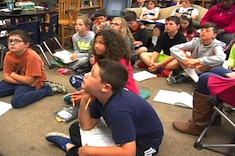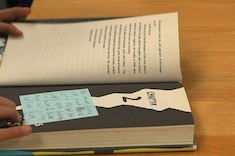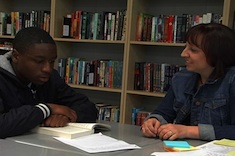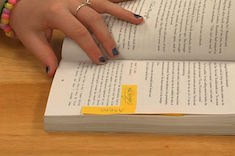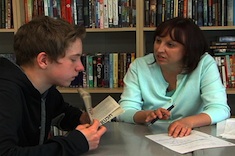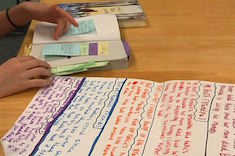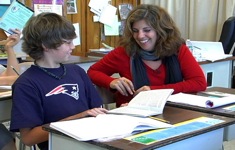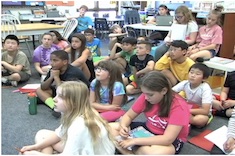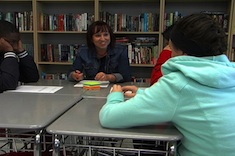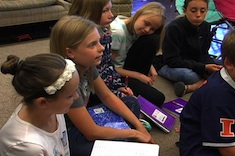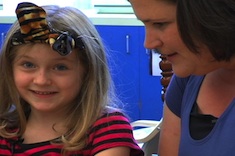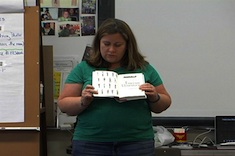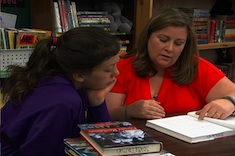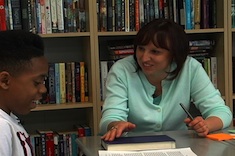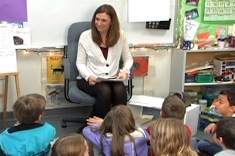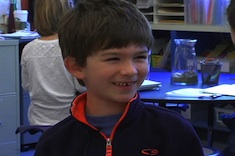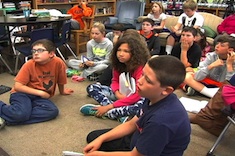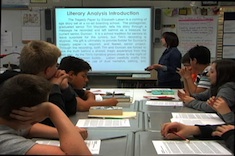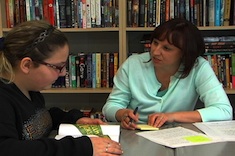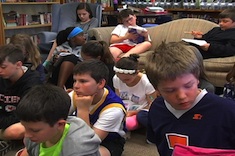Videos
Here is where you’ll find all the latest videos from our contributors. These videos are all captured in classrooms with crews using multiple cameras during regularly scheduled reading and writing workshops.
Latest Content
Fourth-Grade Minilesson: Character Traits
Gigi McAllister helps her fourth graders develop the characters in their writing with a minilesson. She uses three mentor texts, one of which is her own writing.
Enticing Young Readers: First-Grade Group
Bitsy Parks helps a small group of first graders engage with the library early in the year by introducing a series with companion stuffed animals.
Fifth-Grade Book Talk: Wish Girl
Katherine Sokolowski builds interest in a new book in the classroom library through a book talk on Wish Girl.
First-Grade Read and Think Check-In
Katrina Edwards demonstrates a read and think check-in from her first-grade classroom.
Student Notes: Slow Down and Think
Fifth grader Orion uses sticky notes to make questions and predictions at the end of each chapter.
Student Notes: Reading for Writing
Reagan, a fifth grader in Franki Sibberson's class, explains how she uses sticky notes to flag examples of writer's craft she could use in her own writing.
From Title to Theme: Conferring with Jadev
Christy Rush-Levine confers with Jadev about how the title of a book often gives clues to its theme.
Student Notes: Reminders for Later
We continue our video series from Franki Sibberson's class of fifth graders explaining how they take notes while reading. Sarah marks important elements early in the mystery she is reading, so she can easily refer to them later.
Understanding War: Conferring with Cam
Christy Rush-Levine confers with Cam, an eighth grader who seeks to understand the complexity of war through the experiences of main characters in novels.
Student Notes: Keeping Track of Many Characters
Tre uses lots of sticky notes to sort through and keep track of characters in a book with a whole classroom full of personalities.
Student Notes: Experimenting with Two Strategies
What do student notes from independent reading look like when students have free choice? In this video series, fifth graders from Franki Sibberson's class explain their notetaking strategies. We start with Ally, who tries out two different strategies to figure out which one will help her the most.
Conferring: Establishing a Setting in a Novel
In this week's video, Aimee Buckner has a quick conference with a fourth grader about ways to solve a dilemma — how to figure out the setting in a historical fiction novel when there are no pictures.
Leads Minilesson
This fifth-grade minilesson from Franki Sibberson is a lovely mix of mentor texts, Franki's own writing, and honesty about the writing process.
Using a Storyboard for Reflection and Comprehension
Christy Rush-Levine shows a group of three students how they can use a storyboard to help track thinking while reading.
Talk Guide
Gigi McAllister presents a guide to her fourth-grade students to improve talk in reading trios.
Group Meeting: Sharing Resources for Animal Study
Katherine Sokolowski helps her fifth-grade students expand their territory for their animal research projects by sharing information sources and peer connections.
First-Grade Conference: Reading with Feeling
In this week’s video, Katrina Edwards confers with first grader Ellie. She helps Ellie read more fluently and with expression by transferring her feelings to those of characters.
Book Talk: “The Last Fifth Grade of Emerson Elementary”
Katherine Sokolowski demonstrates her book talk skills when she presents The Last Fifth Grade of Emerson Elementary to her students late in the school year.
Building a Next-Read Nonfiction Stack
Katherine Sokolowski helps fifth grader Jack build a next-read stack of nonfiction, highlighting a variety of text features and historical references.
Peer Support in Writing Workshop: Conferring with Jaden
Christy Rush-Levine meets with eighth grader Jaden, who talks through his struggles in writing a conclusion to his literary analysis, and how his peers helped him improve the writing.
Object Poetry Lesson in Second Grade
Linda Karamatic explores poetry with her second graders. She displays poems students have written and teaches them about fresh language using a poem about a pencil sharpener.
Grammar Instruction in Fourth Grade
Melanie Meehan coaches a fourth-grade teacher who is trying to improve his grammar instruction.
Writing Minilesson: Feelings
Katrina Edwards uses read alouds as mentor texts for writing minilessons in her first-grade classroom. In this example she focuses on character feelings.
Conferring in First Grade: Focus on Goals and Strengths
Katrina Edwards confers with first grader Wyatt about his goal of increasing the volume of his reading, helping him self-assess what’s going well and what lies ahead.
Big Question Minilesson
Katherine Sokolowski models how readers make choices as questions arise while reading independently. She also demonstrates how she moves between a novel and web resources.
The Importance of Context Minilesson
Christy Rush-Levine uses a vivid anecdote from her youth to teach her middle school students about the importance of context in literary analysis.
Close Attention and Reading Response: Conferring with Tori
Christy Rush-Levine confers with eighth grader Tori about her reading response to Why We Broke Up. She encourages Tori to make connections between the characters in her current book and her previous reading by paying close attention to surprising action.
Minilesson: How to Retell a Story
Katrina Edwards uses the children’s books They All Saw a Cat and Be a Friend for a minilesson with her first-grade students on how to retell stories with a partner during reading workshop.
Quick-Write with a Video Prompt
Katherine Sokolowski refreshes the quick-write routine in her fifth-grade classroom by using a video as a prompt.
First-Grade Conference: Stretching Writing
Katrina Edwards helps her adorable first-grade student Dylan stretch out his writing. He adds details by first talking about playing with friends near his home.
Browse Content By
Type
Category
- Assessment Tools
- Big Fresh Archives
- Booklists
- Choice Numeracy
- Classroom Design
- Common Core
- Community Building
- Conferring
- Content Literacy
- Digital Literacy
- English Language Learners
- Equity
- Family Relations
- Free Samples
- Guiding Groups
- Leadership
- Literacy Coaches
- Mentor Texts
- Minilessons
- New Teacher Mentors
- Podcasts
- Poetry
- Quote Collections
- Reading Strategies
- Self Care
- Struggling and Striving Learners
- Talking and Listening
- Teacher Study Groups
- Teaching Reading
- Teaching Writing
- Word Study and Vocabulary
Author
- Melissa Quimby
- Nawal Qarooni
- Gwen Blumberg
- Julie Cox
- The Lead Learners
- Hannah Tills
- Josie Stewart
- Ruth Metcalfe
- Mallory Messenger
- Becca Burk
- Jodie Bailey
- Vivian Chen
- Mary Brower
- Tiffany Abbott Fuller
- Stephanie Affinito
- Ruth Ayres
- Leigh Anne Eck
- Heather Fisher
- Shari Frost
- Julie Johnson
- Suzy Kaback
- Gigi McAllister
- Shirl McPhillips
- Melanie Meehan
- Cathy Mere
- Debbie Miller
- Tara Barnett and Kate Mills
- Tammy Mulligan
- Dana Murphy
- Bitsy Parks
- David Pittman
- Brenda Power
- Heather Rader
- Matt Renwick
- Mandy Robek
- Christy Rush-Levine
- Gretchen Schroeder
- Jen Schwanke
- Brian Sepe
- Katherine Sokolowski
- Stella Villalba
- Jennifer Vincent
Grade Level
Choice Literacy Membership
Articles
Get full access to all Choice Literacy article content
Videos
Get full access to all Choice Literacy video content
Courses
Access Choice Literacy course curriculum and training

